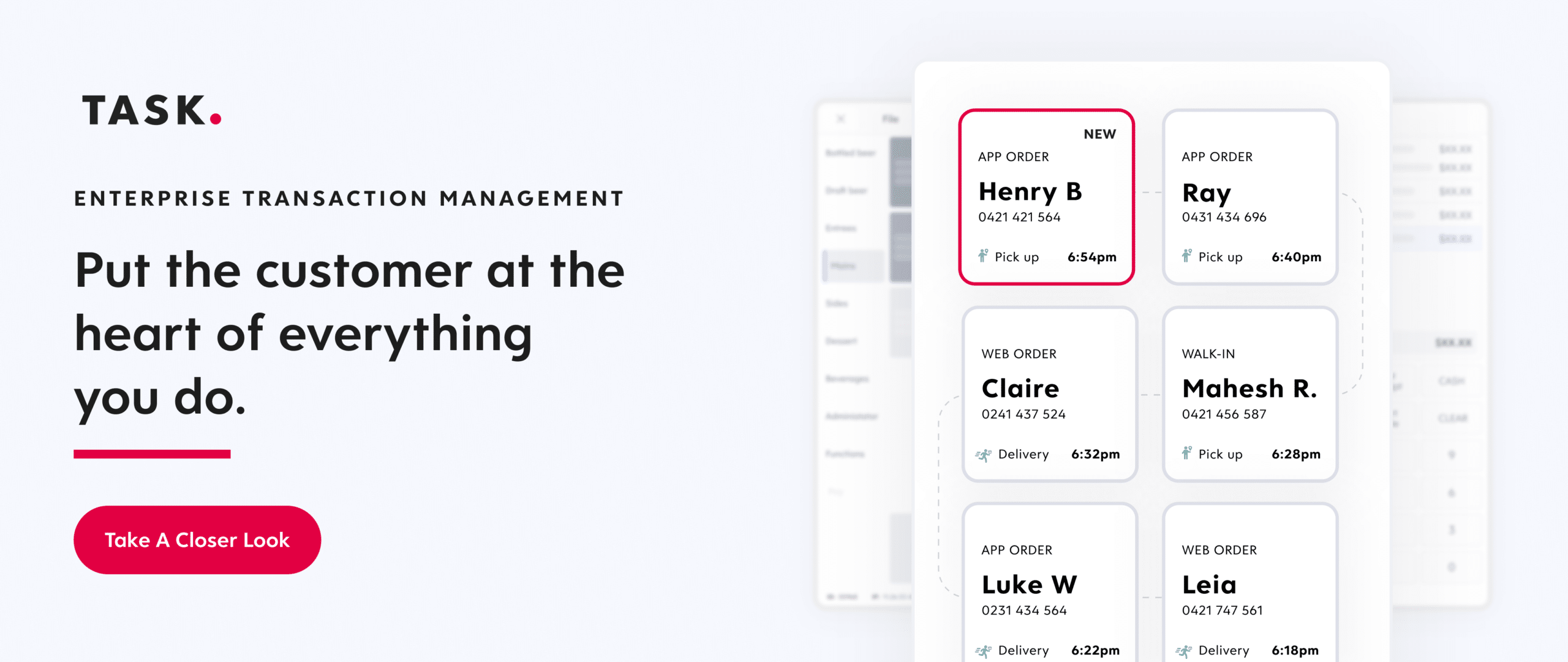Expanding your brand’s influence starts by building a scalable, efficient operations model that can be franchised and replicated across new or untapped markets. However, with mounting financial and logistical pressures on the restaurant industry – from drastic labor shortages to spiking food prices – it’s important that technology is used to help deliver better service, consistency, and optimization.
Consider, for example, how implementing self-service kiosks across a restaurant chain can help drive growth. This piece of smart technology not only cuts down on lines and wait times, but it also reduces the rate of wrong orders, frees up time for staff members, and leads to higher order values.
As TASK’s President of North America John Laporte explains, “A self-service kiosk might begin, like many technologies, as a tool for pain avoidance – a way to streamline the ordering process. However, the wider implications end up offering so much more than that. Approaching growth and technology starts by considering how a new piece of tech is going to influence the customer and staff experience.”
If you’re a brand looking to fuel franchise growth, then start by leveraging new technologies that both improve your customer experience and add workflow efficiency. Choosing, sourcing, and implementing digital options can be difficult for growing hospitality franchise businesses. Here’s what you should know about new tech, and how to use it to its full potential to fuel franchise growth.
How Technology Helps Drive Better Experiences and Efficiency
While the pandemic might now be more or less a part of history, the effects of Covid across the hospitality industry are still changing and shaping businesses. According to McKinsey, nearly one in five restaurant businesses in the US that existed in 2019 will be closed by 2024 because they simply can’t keep up with post-pandemic demands.
Customer expectations have never been higher, while inflation and staff shortages continue to grow. To overcome those conflicting problems, the hospitality industry must turn to technology to fill the gaps. However, spotting the most effective opportunities for digital transformation can be tricky. These are the top traits to look out for when deciding on the next step for your business.
Look for tech to help standardize your processes
There are a wealth of opportunities in the AI and automation space – especially when it comes to our kitchen workflow, ordering system, and inventory management. As Trevor Dee, TASK’s Vice President of Business Development, explains, “A restaurant inventory management system – or RIM – should stand at the center of your business. People often see this tool as a cost-saving mechanism, but it goes further. RIMs help you streamline everything, making it possible for staff to place orders at the counter, communicate with the kitchen, set expectations with customers, and cut down significantly on food waste and sunk costs.”
Seeking out tools that help offer better quality and service standardization – whether that involves transitioning to digital menus or QR code ordering or voice AI in your drive-thru window – puts less pressure on your staff and therefore your resources. John says, “Be open to AI technology. We will be seeing new tools in high-definition video, automated voice-ordering, and opportunities for personalization. There’s a lot of space to take your customer experience to the next level with these kinds of innovations.”
Unlock New Potential for Your Hospitality Business With Data Analytics
Data can offer a strategic edge to optimizing every aspect of your business – so how are you leveraging it right now?
Enhance Your Customer Experience at Every Step
“Remember,” says John, “that faster, easier solutions for your customers are almost always going to mean the same for your staff and business.” Increasing your operational efficiency from the outside-in not only makes your process more streamlined – and therefore, lucrative – but it also means offering customers a better experience.
Focusing on omnichannel offerings and seamless digital platforms should be at the top of the list for any hospitality enterprise. That means having a well-functioning app and website and incorporating a clear, easy-to-use loyalty program throughout your in-store and online channels. Contactless options for ordering and payment, whether through self-ordering kiosks or mobile order and pickup, should also be part of your suite of offerings to ensure that customers have limitless choices with minimal hassle.
Use Tech to Support (not to Replace) Your Staff
“At the heart of this industry is developing personal connections with your customers,” says John. “It’s important not to discredit the value of your staff in forging those real relationships with a smile and a friendly in-store experience.” When implementing technology, the goal isn’t necessarily to get rid of your staff, but rather to help them perform more efficiently and with less effort.
Using automation can help staff carry out redundant or meticulous tasks – such as taking inventory, compiling sales reports or tracking employee performance – in a fraction of the time. This gives your talented people more space to innovate and improve your business and reduces stress levels, which helps you drive better retention rates.
Support Franchise Sustainability
Updating operating procedures, according to researchers, should be the top priority for restaurants that want to see increased engagement with their brand. When your workflow is smooth, your customers will receive faster service at a consistently high quality.
Customer-facing POS systems, such as self-order kiosks, tableside ordering, or mobile order and pay help support ongoing operations across franchise locations. Trevor explains, “Enterprise transaction management systems mean that businesses can update menus, prices, and ordering experiences across locations at any time.” This means total control at a massive scale – without slow and clunky change rollouts – and the ability to immediately fix any issues that come up.
Develop Stronger Marketing Campaigns
Understanding how digital innovation fits into your brand and business is crucial if you want to make smarter, more relevant decisions about using tech for growth. Integrated POS technology makes it easy for brands to collect, segment, and analyze customer data – allowing for more targeted, effective marketing campaigns.
TASK Group’s Chief Strategy Officer for Plexure Division, Kathryn Byrne, is an expert in digital loyalty and personalization. She explains, “Data is the foundation of understanding your customers and making better business decisions. Loyalty programs and strong marketing campaigns are about much more than just driving higher customer values – they are also fantastic opportunities to gather insights that lead to long-term business growth and brand recognition.”
How to Create a Unique Curated Customer Experience
Automation is helping restaurants work smarter – but how can it be used to create better customer experiences at the same time?
How to Implement New Technology Seamlessly
“One of the most common mistakes businesses make,” says John, “is holding onto their legacy technology systems for far too long.” For the most impactful digital transformation, hospitality enterprises should seek out a fully integrated, single-system solution that can connect every tool in their digital framework.
The best way to incorporate new technology into your business is by seeking out tools that:
- Integrate across your entire digital framework
- Support better customer experiences across in-person and digital channels
- Can be easily taught to and understood by your staff
- Allow for scalable future growth
As Trevor explains, “Digital fragmentation happens when each piece of tech operates a different aspect of your business and then can’t integrate properly. The future of this industry is embracing more of a digital ecosystem mindset, and that’s where the true value and efficiency of these technologies becomes crystal clear.”
That doesn’t mean, however, that to employ a new piece of tech you have to upgrade everything all at once. For businesses taking a more cautious approach, it may make the most sense to implement one tool at a time. In this case, it’s important to consider how that new tool will eventually integrate and fit into your entire digital framework and leave room for growth and evolution.
Once your business has selected and implemented a new tool, it’s also important to ensure that your staff is trained on how to effectively use that technology. Considering the training process, and whether the new software or device is intuitively designed, should also be part of the selection process.
The Best Restaurant Technology is Designed with a Growth Mindset
Restaurant businesses that thrive in a competitive market are using technology to approach their operations, customer experience, and brand development. It’s important to work with a technology partner that understands how growth and technology are interconnected.
As General Manager for TASK Groups, Plexure Division Russ Bennett emphasizes, “Investing in the right digital tools now is what makes it possible for you to widen your audience later. Scalability, from our perspective at TASK Group, isn’t about doing everything right now – it’s about laying the groundwork to support anything later.”
To take the next digital step for your business, be sure to consider beyond just step one and think about how each new tool and capability can be translated across a growing network of franchises. In a fiercely competitive market, this will enable your brand not only to adjust quickly to shifting in customer demands but also to seamlessly expand and accommodate future growth.

